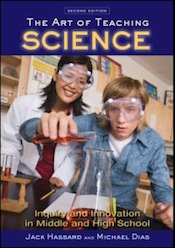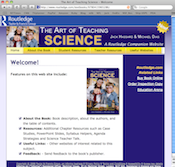Contents
Part 1. The Art of Teaching Science
Chapter 1. The Art of Teaching Science: A
Reconnaissance
Chapter 2. Science
for All
Chapter 3. Facilitating
Science Learning
Part 2. The Goals and the Curriculum of School
Science
Chapter 4. On the History of Science Education
Chapter 5. Science in the School Curriculum
Chapter 6. Science, Technology and Society in the
Science Classroom
Part 3. Connecting Theory and Practice in
Science Teaching
Chapter 7. How Adolescents Learn Science
Chapter 8. Models of Science Teaching
Chapter 9. Designs for Learning
Part 4. Strategies of Science Teaching
Chapter 10.
Assessing Active Science Learning
Chapter 11. Strategies Fostering Thinking In The Science
Classroom
Chapter 12. The Internet:
Learning Science with Online Resources
After The Art of Teaching Science had been in print for two years, I approached Maura Roessner, Senior Editor of Oxford University Press with the idea of publishing a second edition of the book. She fully agreed that a second edition was warranted, but suggested that an Oxford publication would not be in my interests because they were not publishing in the area of science education, and she felt that finding a publisher that could give the book a full supportive effort would be a better choice for me. She offered full support that would enable a smooth transition to a new publisher. I agreed with her, but now faced the challenge of finding a new publisher.
In January 2007, I read on the NARST listserve that Joseph Krajcik and Charlene Czerniak had published a 3rd edition of their book Teaching Science in Elementary and Middle School: A Project-Based Approach with Lawrence Erlbaum. I had thought about Erlbaum as a potential publisher for the 2nd edition, but I didn’t know anyone in their education department. After contacting Dr. Czerniak, she graciously gave me Lane Akers name as the editor that published her book. The publication of her book was a publication that had been a transition from another publisher! I wrote to Lane Akers, and found that Lawrence Erlbaum had merged with Routledge. Lane indicated that he was interested, and I sent a brief proposal and a copy of The Art of Teaching Science to him. Soon thereafter I was put in touch with Catherine Bernard, Senior Editor at Routledge, and after a few emails and a phone conversation, agreed that The Art of Teaching Science would fit with their science education publishing plans.
During these conversations, I decided that I would like to invite another science educator to join me in authoring the second edition. Naturally, I asked Michael Dias if he would be interested joining me, and he agreed. Mike had been one of the reviewers of the Oxford edition of the book, and had used the book in several of his courses at Kennesaw State University and the University of Georgia. He knew the book as well as anyone. But more importantly, Mike and I had by this time known each other for nearly ten years, and had worked together in teaching and writing projects.
Mike Dias and I collaborated on the proposal for the second edition of The Art of Teaching Science and sent it off to Routledge. We wrote the revision from June 2007 to January 2008, making changes to the organization of the book along the way. Routledge had provided us with five reviews of The Art of Science Teaching, and we used these reviews to sharpen the focus of the book, which is outlined in the Introduction, which follows.
The 2nd Edition of The Art of Teaching Science was organized into four parts, as shown above. We geared the revision and organization of the text to align with science education programs situated in classrooms, rather than as isolated courses of study at the university. Following the earlier versions, we emphasized the contextual dimension of learning to teach, and provided experiences throughout the book that would coincide with students experiences in schools with mentors, peers and students.
For the 2nd Edition of the book, we developed an extensive Companion Website as shown in the sidebar. In truth, the Companion Site was developed to provide users of the books with resources that we were not able to include in the book because of the desire to shorten the manuscript.
The Second Edition carried forward four pedagogical learning tools that are unique and fundamental to The Art of Teaching Science, and they are:
- Inquiry Activities
- Case Studies
- Science Teacher Talk Interviews
- Global Perspective
Inquiry Activities: We have included 33 Inquiry Activities that are embedded in the text, and are designed as way to bring social constructivism to the book. The Inquiries are designed as collaborative activities, and can be used to engage learners in investigations, discussions, debates, observations, reports, and interactions on the key ideas developed in The Art of Teaching Science. Here are a few examples of Inquiry Activities that you can read online to review this pedagogical learning tool.
Case Studies: In the Second Edition we refer to the case studies as "cases to consider," and we use them to open each chapter. In many ways the case can be used to enable readers to compare and contrast their pre-existing ideas about the content of the chapter. We also have included additional cases on the Companion Website which can be located within each Chapter link in the Student Resources section. You can read an example of "The Student Who Just Can't Relate to This Physics Stuff."
Science Teacher Talk Interviews: These are "wisdom-of-practice" interviews that we conducted with three groups of 24 teachers. The first group of six teachers was interviewed for the 1992 publication of Minds on Science, the second group, comprised of nine experienced teachers representing five countries, and three first-year teachers who were graduates of the TEEMS Program were interviewed for the First Edition of the Art of Teaching Science, and 6 additional teachers for the Second Edition. We used a questionnaire which was developed for Minds on Science, and modified for the editions of The Art of Teaching Science. The interviews are organized by chapter. I've included all of the interview questions for your review in the sidebar, with links to each chapter on the Companion Website enabling you to read the teachers' responses to all of the questions.
Global Perspective: Because of my involvement with the Global Thinking Project, which emerged from the AHP Soviet-Exchange Project discussed elsewhere in this website, I asked educators from several countries to write short essays describing science education in their respective countries. For the Second Edition, you will find outstanding essays describing science education in:
· Australia
by Roger T. Cross
·
Chile
by Claudia Rose
·
China
by Ronald F. Price
·
Ghana
by Charles Hutchison
·
Japan
by Shigehiko Tsukahara
·
Russia
by Sergei Tolstikov
·
Turkey
by Fatih Tasasr

